Visit the Tuileries Garden in Paris
The Tuileries Garden (Jardin des Tuileries in French) is one of the most famous gardens in Paris. This green oasis in the heart of Paris receives more than 14 million visitors every year.
The Tuileries Garden is the biggest Park in Paris (23 Hectares), and it is also the oldest. It is located in the First Arrondissement of Paris, between the Louvre Museum and Place de la Concorde, and it is delimited by the Seine River and Rue de Rivoli.
Because of its central location, beauty, and rich history, the Tuileries Garden is one of the top things to do in Paris. So get ready to be overwhelmed by the fascinating history and beauty of this awesome garden in Paris.
The Tuileries Garden is one of the top places to visit in Paris. We recommend visiting the Tuileries Garden in the following Paris itineraries:
- 1 day in Paris itinerary
- 2 days in Paris itinerary
- 3 days in Paris itinerary
- 4 days in Paris itinerary
- 5 days in Paris itinerary
- 6 days in Paris itinerary
- 7 days in Paris itinerary

Where to Stay Near the Tuileries Garden
The Tuileries Garden area is central and with a wide choice of boutique hotels, furnished apartments, and trendy bars and restaurants. From here, you can visit the Louvre Museum, Royal Palace, Place Vendôme, Place Concorde and the banks of the River Seine on foot.
In addition, this area is served by metro line 1, one of the few automatic lines in the Parisian metro. This means that even if there’s a transportation strike, you will always have the metro running!
Click on the map to find where to stay near the Tuileries Garden.
Tuileries Garden Facts
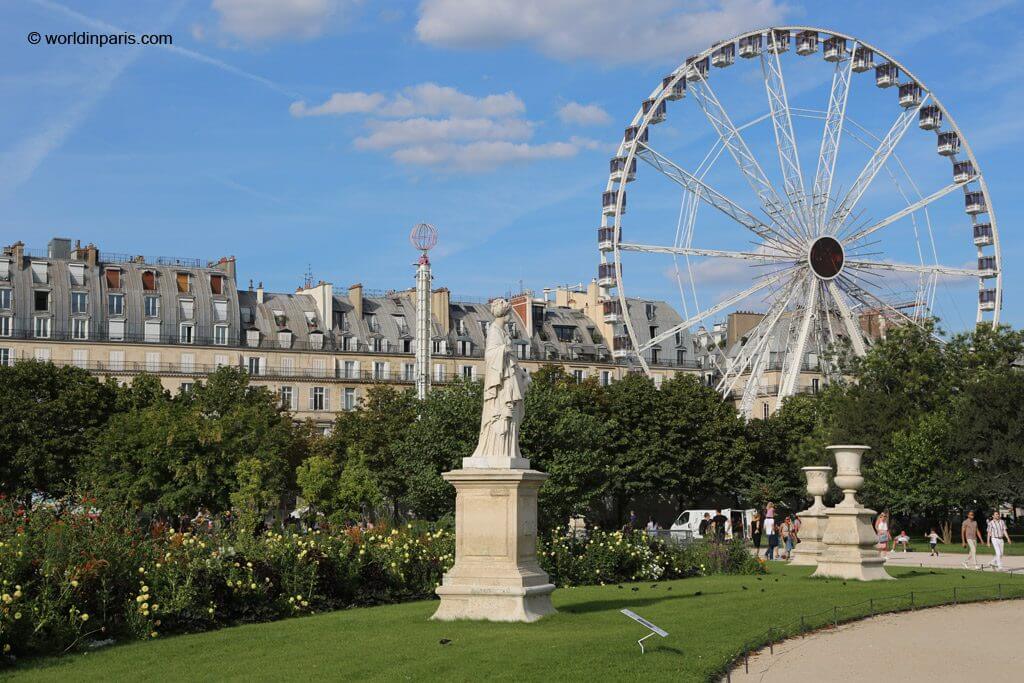
» The Tuileries Garden was commissioned by King Henri II’s wife, Cathérine de Médicis, in 1561 as part of the new Tuileries Palace. Before the construction of the Tuileries Palace, these grounds were occupied by tile kilns (tuileries in French), hence the name of the Tuileries Palace and Gardens.
» André Le Notre, the same landscape designer of the Versailles Gardens, was in charge of the Tuileries Garden’s design.
» When King Henri II died in 1559, Cathérine de Médicis moved from the Louvre Palace to the Tuileries Palace, and the Tuileries became the main royal residence. Since then, the Tuileries Palace and its gardens have been intimately linked to the history of France, with glorious celebrations and bloody episodes.
» During three centuries, the Tuileries Garden was exclusively reserved for the King and his court. The Tuileries Palace was home to Cathérine de Médicis, Napoleon I, Louis XVIII, Charles X, Louis-Phillipe, and Napoleon III. Other French Kings used the Palace and gardens for leisure activities, private parties, and official events.
» With the onset of the French Revolution and the execution of King Louis XVI and Queen Marie-Antoinette, the Tuileries Garden became a National Garden of the French Republic. It was then when the Parisians could access the Tuileries Garden for a stroll under the sun. During those years, popular balls and music in the Tuileries Garden were also common.
» The Tuileries Garden remained the setting for festivals and ceremonies under Napoleon I. It took the form of a museum of outdoor statuary populated by the transfers of statues from Versailles, and other castles near Paris.
» The Palace was destroyed by a big fire during the Paris Commune in 1871. It was only after the Tuileries Palace was burned to the ground that the Tuileries Garden became a public park.
» In 1991, the Gardens were listed as UNESCO’s World Heritage, together with the banks of the Seine. Today, they are managed by the Louvre Museum.
Tuileries Garden Map
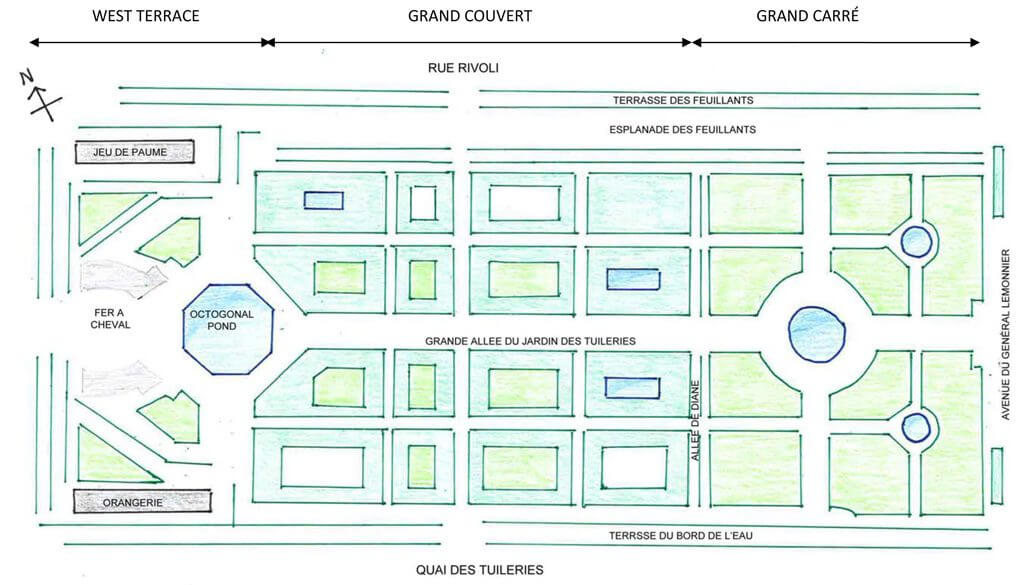
The Tuileries Garden is a French-style garden with a very geometric design. The Tuileries Garden map can be divided into three main areas:
The Grand Carré (Large Square) is the eastern, open side of the Tuileries Garden, which still follows the formal plan of the French-style Garden created in the 17th century.
The Grand Couvert is the central part of the garden and it is covered by trees. It has two guinguettes (popular drinking establishments which would also serve as restaurants and, often, as dance venues) serving food and drinks. These two guinguettes in the Grand Couvert are named after two famous cafes once located in the garden:
- The Café Very, located on the terrace des Feuillants in the 18th–19th century;
- The Café Renard, a popular meeting place on the western terrace in the 18th century.
The West Terrace of the Tuileries Garden is located beside the present-day Place de la Concorde. It has two ramps in a horseshoe shape (Fer à Cheval) and two terraces overlooking an Octagonal Lake (Bassin Octagonal). The terraces frame the western entrance of the Tuileries Garden and provide a great viewpoint to see the garden from above. From here, you also have an interesting view of the Luxor Obelisk and one of the best views of the Eiffel Tower.
Best Things to Do in The Tuileries Garden
Admire the Trees, Plants, and Flower Arrangements
Visitors interested in botany and plant species will not be disappointed: the Tuileries Garden boasts some 35 species of trees and dozens of varieties of flowers – from annuals to perennials – located particularly in the central beds of the Grand Carré.
Every year, the gardeners create new spring and summer floral arrangements in line with the Louvre Museum’s cultural calendar.
Learn about the Garden’s Quirky History with our Tuileries Garden Scavenger Hunt
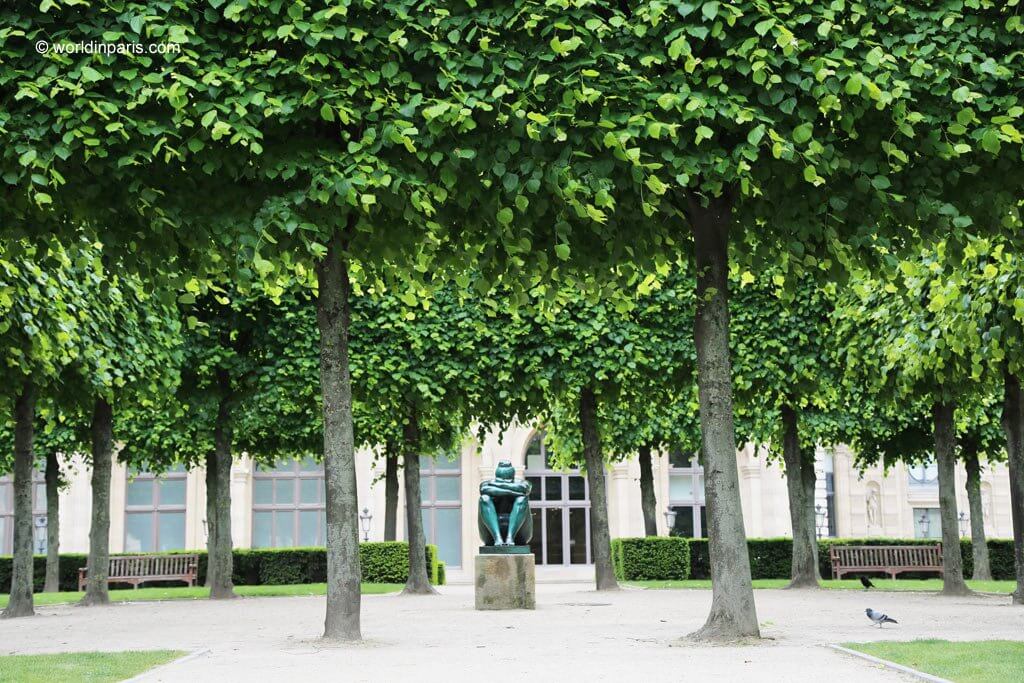
The Scavenger Hunt in the Tuileries Garden is a self-guided Scavenger Hunt + Walking Tour perfect for those who want to learn the history of this fascinating place whilst having fun. It is perfect for families, groups of friends but also for solo visitors.
With this Scavenger Hunt in the Tuileries Garden, you will follow the clues that bring you to interesting sights inside the garden and not-so-well-known secrets. Solve all the clues to figure out the final answer!
Visit Monet’s Water Lillies at Musée de l’Orangerie
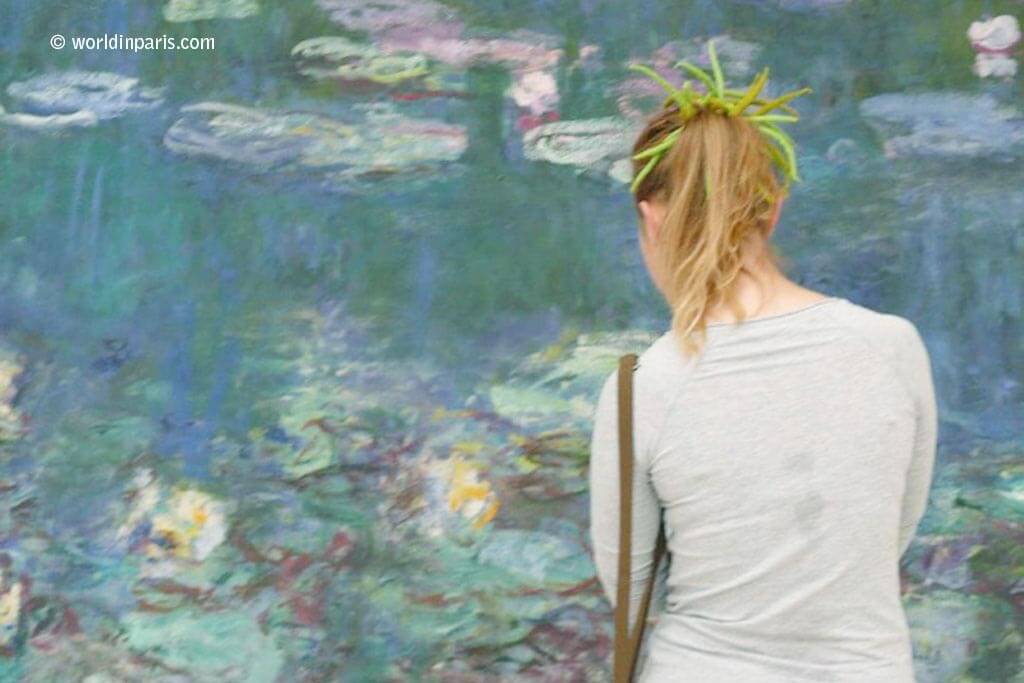
The Musée de l’Orangerie is one of the twin buildings located on the West Terrace. In the past, it was used to grow oranges, hence the name.
The Orangerie in Paris is best known for Monet’s water lilies, displayed in a special, oval room. Admire these incredible paintings by Monet and an interesting collection of Modern Art paintings by great masters such as Renoir, Modigliani, Cezanne, and Matisse.
Buy your tickets to Musée de l’Orangerie
TIP: Skip the line and save money with this combo ticket Orangerie + Orly Museum!
Visit a Photography Exhibition at Jeu De Paume
The Jeu de Paume is the twin building located on the north of the West Terrace. In the past, this building was used to play the Jeu de Paume, a French indoor game precursor of tennis but played without rackets.
Today, the Jeu de Paume hosts interesting photography exhibitions about modern and postmodern photography and media.
Relax in one of the Two Guinguettes Inside the Park
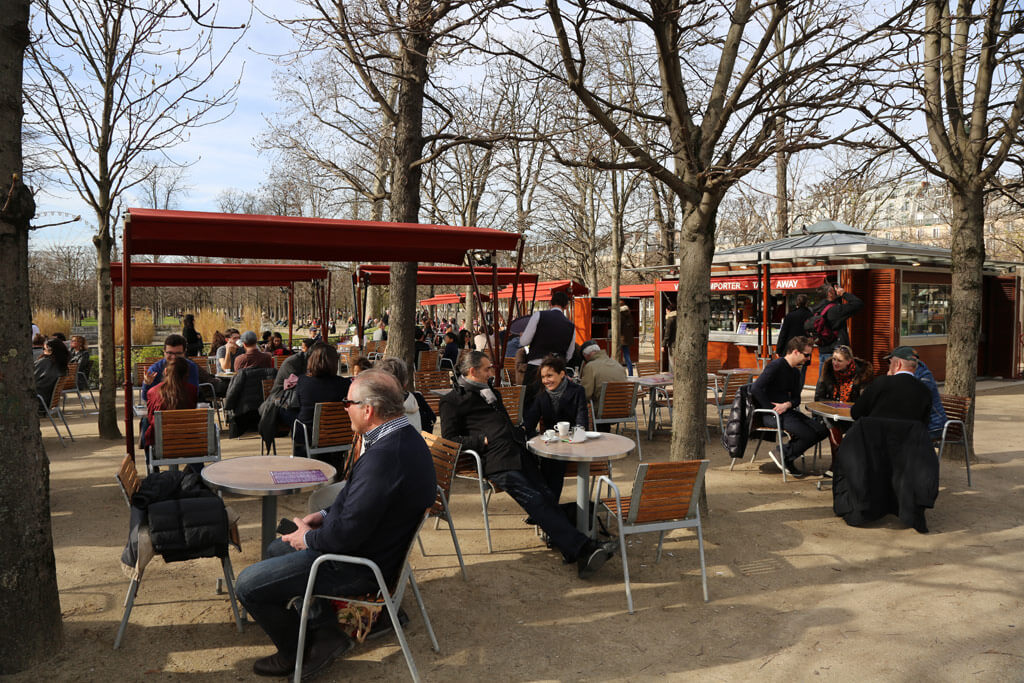
The two guinguettes inside the park, Café Very and Café Renard, offer visitors coffee, crêpes, and other quick eats under the shade of the trees and in a tranquil atmosphere.
The Tuileries Garden for Kids
The Tuileries Garden is also a fun place for kids to be. Children can sail wooden boats of all colors on the Grand Bassin or enjoy a ride on the beautiful ancient carrousel, with imagery recalling the magical universes created by the French children’s author Charles Perrault.
Inside the park, there is also a playground area and some trampolines.
Enjoy one of the Best Christmas Markets in Paris
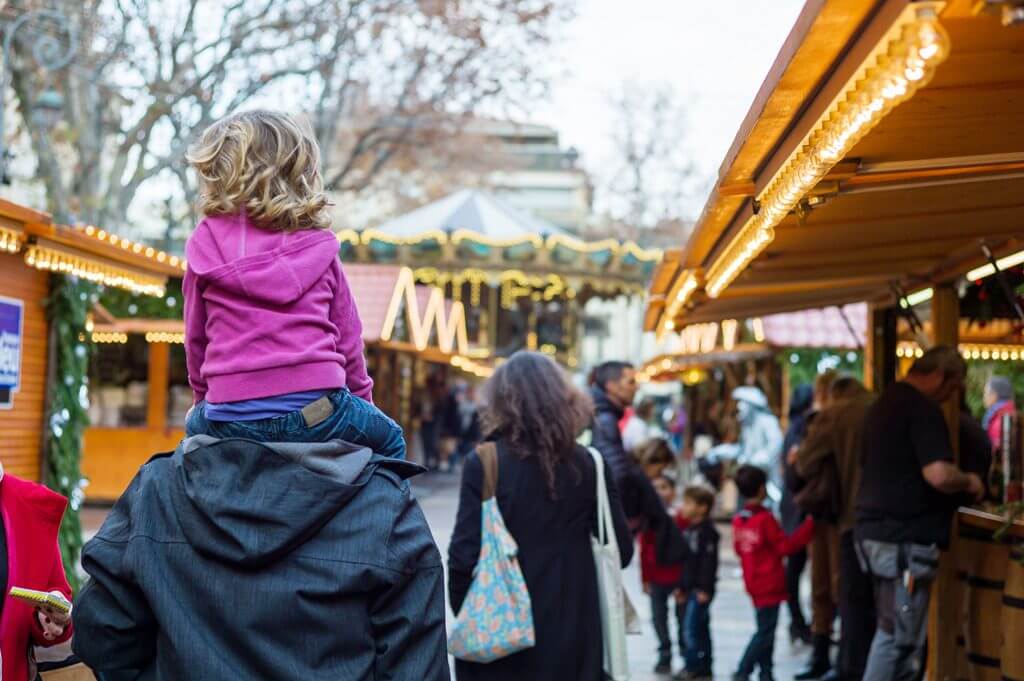
During Christmas in Paris, between mid-November to the beginning of January, the Tuileries Garden hosts one of the best Christmas Markets in Paris. Here, the wooden chalets offer beautiful handicraft items, quick food, and there are also some rides and an ice rink for kids and adults.
Check out our quick guide to the Tuileries Garden Christmas Market.
Tuileries Garden Statues
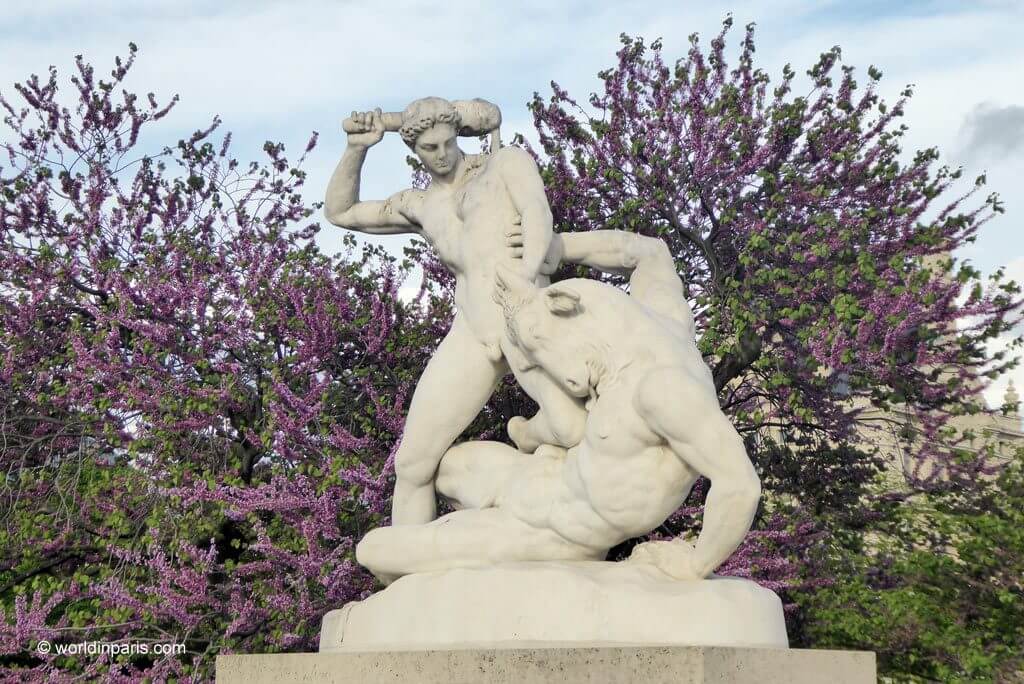
The Tuileries Garden is like a big open-air museum with dozen of sculptures and statues decorating the park. The first Tuileries Garden statues (today reproductions) arrived in the 18th century from the gardens of Versailles, Fontainebleau, and Marly, while more recent works include statues by Rodin, Moore, and Maillol.
What to Do Near the Tuileries Garden in Paris?
- Louvre Museum
- Seine River Cruise
- Palais Royal
- Pont Neuf
- Place Concorde
- Place Vendôme

